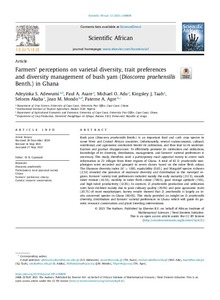| dc.contributor.author | Adewumi, A.S. |
| dc.contributor.author | Asare, P.A. |
| dc.contributor.author | Adu, M.O. |
| dc.contributor.author | Taah, K.J. |
| dc.contributor.author | Akaba, S. |
| dc.contributor.author | Mondo, J. |
| dc.contributor.author | Agre, A.P. |
| dc.date.accessioned | 2021-07-27T09:47:48Z |
| dc.date.available | 2021-07-27T09:47:48Z |
| dc.date.issued | 2021 |
| dc.identifier.citation | Adewumi, A.S., Asare, P.A., Adu, M.O., Taah, K.J., Akaba, S., Mondo, J.M. & Agre, P.A. (2021). Farmers’ perceptions on varietal diversity, trait preferences and diversity management of bush yam (Dioscorea praehensilis Benth.) in Ghana. Scientific African, 12, e00808: 1-14. |
| dc.identifier.issn | 2468-2276 |
| dc.identifier.uri | https://hdl.handle.net/20.500.12478/7186 |
| dc.description.abstract | Bush yam (Dioscorea praehensilis Benth.) is an important food and cash crop species in some West and Central African countries. Unfortunately, several socioeconomic, cultural, nutritional, and agronomic constraints hinder its cultivation, and thus lead to its underutilization and gradual disappearance. To effectively promote its cultivation and utilization, knowledge of its diversity, distribution, management, and farmers’ varietal preferences is necessary. This study, therefore, used a participatory rural appraisal survey to assess such information in 23 villages from three regions of Ghana. A total of 42 D. praehensilis morphotypes were recorded and grouped in seven classes based on the tuber flesh colour. The Shannon diversity index (H’ = 1.88), equitability (0.65), and Margalef species richness (2.53) revealed the presence of moderate diversity and distribution in the surveyed regions. Farmers’ variety trait preferences included mainly the early maturity (21.1%), smooth tuber texture (16.5%), stability in tuber flesh colour (7.86%), good storage aptitude (7.6%), and high tuber productivity (12.8%). In contrast, D. praehensilis production and utilization rates have declined mainly due to poor culinary quality (39.9%) and poor agronomic traits (20.7%) of most morphotypes. Survey results showed that D. praehensilis is largely an in-situ conserved species in Ghana (60.0%). This study provided an insight on D. praehensilis diversity, distribution and farmers’ varietal preferences in Ghana which will guide its genetic resource conservation and plant breeding interventions. |
| dc.description.sponsorship | European Union Commission |
| dc.description.sponsorship | African Union |
| dc.description.sponsorship | Bill & Melinda Gates Foundation |
| dc.format.extent | 1-14 |
| dc.language.iso | en |
| dc.subject | Dioscorea |
| dc.subject | Yams |
| dc.subject | Surveys |
| dc.subject | Ghana |
| dc.subject | Farmers |
| dc.subject | Genetic Resources |
| dc.subject | Resource Conservation |
| dc.subject | Participatory Rural Appraisal |
| dc.title | Farmers' perceptions on varietal diversity, trait preferences and diversity management of bush yam ( Dioscorea praehensilis Benth.) in Ghana |
| dc.type | Journal Article |
| cg.contributor.crp | Roots, Tubers and Bananas |
| cg.contributor.affiliation | University of Cape Coast |
| cg.contributor.affiliation | International Institute of Tropical Agriculture |
| cg.contributor.affiliation | Université Evangélique en Afrique |
| cg.coverage.region | Africa |
| cg.coverage.region | West Africa |
| cg.coverage.country | Ghana |
| cg.coverage.hub | Headquarters and Western Africa Hub |
| cg.researchtheme | Biotech and Plant Breeding |
| cg.identifier.bibtexciteid | ADEWUMI:2021 |
| cg.isijournal | ISI Journal |
| cg.authorship.types | CGIAR and developing country institute |
| cg.iitasubject | Agronomy |
| cg.iitasubject | Food Security |
| cg.iitasubject | Plant Breeding |
| cg.iitasubject | Plant Production |
| cg.iitasubject | Smallholder Farmers |
| cg.iitasubject | Yam |
| cg.journal | Scientific African |
| cg.notes | Open Access Article; Published online: 06 Jun 2021 |
| cg.accessibilitystatus | Open Access |
| cg.reviewstatus | Peer Review |
| cg.usagerightslicense | Creative Commons Attribution 4.0 (CC BY 0.0) |
| cg.targetaudience | Scientists |
| cg.identifier.doi | https://dx.doi.org/10.1016/j.sciaf.2021.e00808 |
| cg.iitaauthor.identifier | Paterne AGRE: 0000-0003-1231-2530 |
| cg.futureupdate.required | No |
| cg.identifier.issue | e00808 |
| cg.identifier.volume | 12 |
| cg.contributor.acknowledgements | Authors acknowledge the provision of research fund to the first author by the ACADEMY project. Directorate of Research, Innovation, and Consultancy of the University of Cape Coast is also acknowledged for managing the ACADEMY project. We appreciate all the local bush yam farmers and agricultural extension service personnel at the three regions surveyed in Ghana. We are grateful to local authorities in all surveyed villages for facilitating data collection. We also thank Daniel Nana-Yaw Gyebi and Azure Kwanema Sanleri for their assistance during the course of the surveys. |

